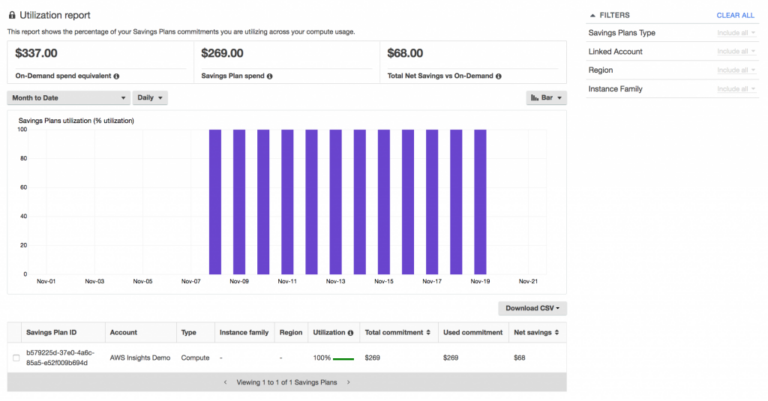Poorly configured and cost-unoptimized Cloud Accounts count for billions of dollars in waste. (This article lists Cloud waste to hit $19 billion by 2019). AWS has consistently promoted the creation of cost-effective architecture as dedicated by Cost-optimization being one of the founding pillars of the AWS Well-Architected Framework that AWS Champions.
AWS offered their customers a chance to get significant discounts on sustained compute usage by utilizing AWS Reserved Instances about a decade ago. Since then, AWS customers have saved billions in AWS costs by opting for Reserved Instances.
A recent survey of cloud trends revealed that around 32% of cloud costs are spent on poorly optimized resources and AWS accounts that do not have planned cost-cutting strategies enabled.
Reserved instances provide around 72% savings as compared with on-demand instances, however, they only apply to EC2 instances.
To provide more value to its customers AWS provided a new offering to their cost-saving with AWS Saving plans.
Saving plans is a new flexible discount model that saves the same as Reserved instances without the added complexity of meticulously planning instances and usage in the long term.
AWS Saving Plans work on a commitment of dollars spent rather than compute used. Every EC2 instance class has on-demand and saving plan prices, for every dollar committed to a saving plan EC2 hourly rates are charged at the reduced saving plan price and regular on-demand pricing applies after Savings plans capacity is consumed.
The best part about AWS Saving plans which makes them easier and better than the Reserved Instance counterpart is that AWS Saving plans comes in 2 options.
Compute Savings Plans – which covers discounts on all EC2 instances, not only EC instances but Compute saving plans which also cover any containers running on Fargate Lambda resources consumed.
Of the two options Compute Saving plans offer the most flexibility, whether a Solution Architect has suddenly moved from running C5 instances rather than the R5 instances for the past six months, or, the development team has shifted a significant chunk of the application to Lambda you can apply the discounts to all significant compute resources.
EC2 Instance Savings Plans – this plan is the most similar to Reserved Instances discount, EC2 instance saving plans apply to one class of an instance type. Instance Saving plans provide the most significant discount (Up to 72%!) on EC2 On-demand pricing, and has the added flexibility of allowing a region change the EC2 instance type and the Operating System, you can set up Saving plans for Linux and even use Windows while on the saving plan.
Purchasing a Savings Plan:
So how does one go about purchasing a Saving Plan in AWS? It is quite simple, just go to the AWS Cost Explorer tab in the AWS Services tab.

One might be tempted to click on Purchase Saving Plans, and it is better to view the Recommendations page first and look at the average spending, this way you use that information to analyze any decisions that need to be made before you buy.
It is advised to play around with the settings to best suit a particular requirement (prefer more cost savings with paying upfront or reserve capital, for example). AWS will use historical data to point out the best recommendations.

Based on the settings above, AWS recommends a single saving plan for one year that will allow around 41$ worth of savings.

If we look at the AWS EC2 spend over the past two months, We can see that the EC2 spend is much more than recommended.

The above example is why it is recommended to not go all in with a single saving plan but instead opt for small incremental buckets of saving plans after viewing other spending analytics.
This is done by reviewing utilization reports and seeing resources covered in the saving plans and whether there is room for improvement, since AWS Saving plans are a long-term (1 year or three-year commitment), it is a well-advised best practice to review, analyze, and procure rather than do a one-time assessment and purchase.

The coverage report informs of any future options for cost savings by showing what compute is being covered by Saving Plans and what services are being charged the On-demand pricing.
Cost optimisation is a science and must be constantly monitored and analised so you cease the opportunities to grow without breaking your budget for the cloud and should start at the development phase of your platforms and applications, with the amount of tools AWS and third party software available you can now empower and enable your teams to be the drivers of Public Cloud cost optimization.

Historically, AWS has only had Reserved instances to provide long-term cost savings. However, Reserved instances provided the highest possible discounts as the cost of complexity, rigidness of choice, and required dedicated research into future computing needs and feasibility studies.
AWS Saving plans have brought much ease to AWS Cost optimization, providing the same level of discounts with much greater flexibility and less complexity. Using AWS Saving plans can help achieve up to 70% cost savings compared to On-demand instances and will help create cost-optimized, saving-based infrastructure.







